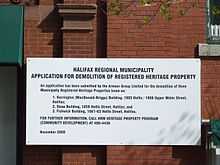Waterside Centre

The Waterside Centre is a controversial development in Halifax, Nova Scotia, Canada proposed by Halifax real estate developer, the Armour Group. The project involves demolishing six heritage buildings to be replaced by a nine story retail and office building with partially constructed facades of the some of the former heritage buildings. Halifax City Council rejected the development in the fall of 2008 but the developer immediately demolished one of the buildings and appealed Council's decision which was overturned by Nova Scotia's Utility and Review Board on March 26, 2009.
The Site
The six buildings occupy a downtown block facing the Halifax waterfront bounded by Upper Water Street, Duke Street, Hollis Street and the Cogswell interchange. Along with the adjacent waterfront buildings of Historic Properties with the Victorian commercial buildings of the Granville Mall, the site is one of the only intact blocks of 19th-century buildings in Downtown Halifax. It includes the oldest storefront in Halifax and the site of the famous 18th-century tavern “The Great Pontack”, where James Wolfe planned the siege of Louisbourg and Quebec. The buildings have housed commercial and retail tenants, but Armour group has said that the buildings are no longer economical and their replacements by facades should be seen as restoration.[1] The buildings on the block include the 1820 Harrington MacDonald-Briggs Building the oldest remaining commercial building in Halifax,[2] the 1861 Fishwick & Company Building,[3] the 1926 Imperial Oil Building [4] as well as the 1840 Sweet Basil Building, the last wooden "sailortown" building on Halifax's Water Street.
The only building on the historic block not facing demolition by Armour group is the Morse’s Tea Building owned by another developer who has converted the 1841 structure for office use and retained its interior and exterior structure.[5]
The Debate

The proposed development has split municipal politicians in Halifax. Those opposed, such as Nova Scotia’s Heritage Trust, say that Halifax is losing its small and dwindling number of heritage buildings which are a resource for culture and tourism. Supporters such as the downtown Halifax Business Commission say that developers should be given a free rein to promote economic activity. The debate has also led Nova Scotia’s Conservative Premier Rodney MacDonald to intervene in the city's politics in support of the development and demolition.[6]
Almost all of the presenters at public hearings in September 2008 opposed the project, including officials in the province's tourism industry.[7] A signature with over 690 names opposing the development was presented to Halifax City Council in October 2008[8] Possible solutions have been suggested include a land swap or a compromise development but to date all have been rejected by Armour Group except for an offer to reduce the office tower by two stories if given large property tax breaks.
The heritage buildings on the block were saved from demolition in the 1970s when heritage advocates stropped a planned Harbourfront expressway promoted by city traffic engineers and developers which would have demolished all older buildings on the waterfront. The move was seen as key to reviving the Halifax waterfront and Halifax's downtown tourism.[9] Heritage proponents have argued that the pending demolition underscores Halifax's weak heritage laws. Unlike most older North American cities, Halifax has no heritage districts preserving blocks of heritage buildings but only has individual building designation which may easily be overturned by developers seeking demolition.
Rejection, appeal and demolition
The development was rejected by the council of Halifax Regional Municipality in a tie vote on October 21, 2008.[10] The head of Armour Group, Ben McCrae, initially said he would not appeal as it would create bad publicity.[6] However Doug MacIsaac of Armour Group announced on October 31 that his company would appeal council's decision to Nova Scotia’s Utility and Review Board, the same day as his company began demolition of the first of the six buildings, the former Sweet Basil restaurant.[11] The Board overturned Halifax council's decision on March 26, 2009, and Halifax council voted on April 7 not to appeal the Board's decision.[12]
References
- ↑ Armour Group Waterside Development Web Page
- ↑ "Harrington MacDonald-Briggs Building" Nova Scotia Historic Places Initiative Database
- ↑ "Fishwick & Company Building" Nova Scotia Historic Places Initiative Database
- ↑ "Imperial Oil Building", Nova Scotia Historic Places Initiative Database
- ↑ "Morse's tea Building" Nova Scotia Historic Places Initiative Database
- ↑ 6.0 6.1 Halifax Chronicle Herald, Oct. 23, 2008, page B2
- ↑ ”Historic Indecision: Waterside Centre”, The Coast Sept. 18, 2008
- ↑ HALIFAX CHRONICLE HERALD Thursday Oct. 23, 2008, page B2
- ↑ "Exploring Nova Scotia Architecture I" Nova Scotia Association of Architects, Halifax: Formac Publishing, page 2.
- ↑ HALIFAX CHRONICLE HERALD Wed Oct. 22
- ↑ HALIFAX CHRONICLE HERALD Saturday Nov. 1, page 1.
- ↑ "City Council Says Yes to Waterside", Halifax Chronicle Herald, April 8, 2009, p. 1
External links
Coordinates: 44°39′7.75″N 63°34′27.57″W / 44.6521528°N 63.5743250°W